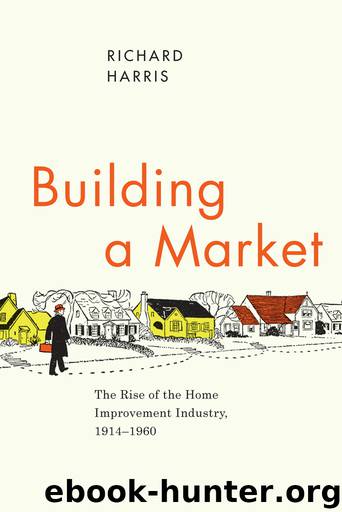Building a Market by Richard Harris

Author:Richard Harris
Language: eng
Format: epub
Publisher: The University of Chicago Press
Published: 2012-03-16T16:00:00+00:00
34. Consumer magazines learn to cater to owner-builders. It took months, and sometimes years, for magazine editors to recognize the magnitude of the amateur building boom. Source: Parents’ Magazine 24, no. 4 (April 1949): 51.
Others, supposedly better-attuned to housing trends, were equally taken by surprise. Disregarding market realities, in 1947 the Housing and Home Finance Agency had tried to help prospective home owners by distributing Planning Expansible Houses. Absurdly, it assumed that readers would hire an “experienced and competent architect.” Small Homes Guide was little better. Still edited by Wadsworth Wood, SHG was directed at those who wanted an affordable small home. Like most other observers, Wood assumed that this would mean mass production. Alternatively, recognizing that some prospective owners would want to build, he supposed they would hire a contractor. He also broached the possibility of hiring an architect, and mused that “your lumber dealer may act as contractor for the whole job.” By 1949, however, such experts were beginning to wake up. Kenneth Duncan changed his tune. In 1949, he wrote an upbeat commentary for bankers about the “surprisingly large number” of owner-builders, conceding that the subject might still occasion “some lifting of the eyebrows among those whose experience is mostly with cities and metropolitan areas.” At SHG, the letters column and a reader survey begun in 1948 forced Wood to change his tune. The survey showed that 55 percent of readers who had recently acquired a home had done at least some of their own work. (A later survey by Popular Mechanics reported that among that journal’s readers, 57 percent planned to do “most” of the work themselves.) In 1949, Wood launched a competition for stories of successful amateurs, and ran articles that offered tips. Late that year, a second survey revealed that 72 percent of buyers were now investing sweat equity, a finding reported by many local newspapers. Although government agencies still managed to ignore or downplay the owner-builder boom, consumer and trade magazines had finally woken up.12
If Corey’s prediction about homesteading was prescient, his comments about a looming housing shortage were common sense. For fifteen years, new construction had fallen behind the growth of housing need. During World War II, federal restrictions on materials had handcuffed the building industry. From 1940 and 1945 the GNP, and total personal incomes, had more than doubled, but the share going to residential construction had fallen from 3.2 percent to 0.6 percent. People had jobs, but nowhere to live.
When veterans came home, the problem ballooned (figure 35).13 Governments geared up to deal with the problem. In Toronto, for example, the city established a reconstruction council to assess the problem and recommend solutions. It showed that the housing backlog had been growing since 1931. Since then, about 8,050 dwelling units had been constructed and another 5,281 were created through conversions, but these were barely adequate for families. In every year from 1931 to 1945, marriages had exceeded new homes built, sometimes by a factor of six. The ultimate measure of
Download
This site does not store any files on its server. We only index and link to content provided by other sites. Please contact the content providers to delete copyright contents if any and email us, we'll remove relevant links or contents immediately.
Life 3.0: Being Human in the Age of Artificial Intelligence by Tegmark Max(5198)
The Sports Rules Book by Human Kinetics(4081)
The Age of Surveillance Capitalism by Shoshana Zuboff(3999)
ACT Math For Dummies by Zegarelli Mark(3858)
Blood, Sweat, and Pixels by Jason Schreier(3500)
Unlabel: Selling You Without Selling Out by Marc Ecko(3476)
Hidden Persuasion: 33 psychological influence techniques in advertising by Marc Andrews & Matthijs van Leeuwen & Rick van Baaren(3305)
Urban Outlaw by Magnus Walker(3250)
The Pixar Touch by David A. Price(3225)
Bad Pharma by Ben Goldacre(3105)
Project Animal Farm: An Accidental Journey into the Secret World of Farming and the Truth About Our Food by Sonia Faruqi(3027)
Brotopia by Emily Chang(2902)
Kitchen confidential by Anthony Bourdain(2837)
Slugfest by Reed Tucker(2809)
The Content Trap by Bharat Anand(2784)
The Airbnb Story by Leigh Gallagher(2710)
Coffee for One by KJ Fallon(2433)
Smuggler's Cove: Exotic Cocktails, Rum, and the Cult of Tiki by Martin Cate & Rebecca Cate(2343)
Beer is proof God loves us by Charles W. Bamforth(2255)
